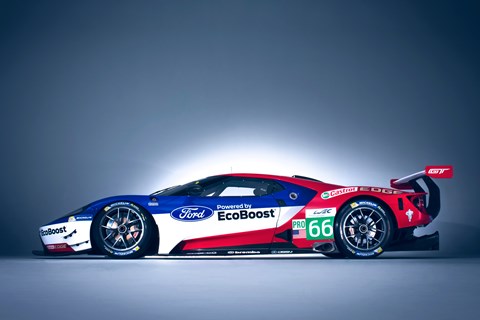► Ford’s 2016 Le Mans drivers confirmed
► Priaulx, Pla, Franchitti and Mücke to pilot GT
► First details of the modern-day GT40 race car
Ford has today announced the driver line-up for its new Ford GT supercar racing programme in Europe, and those drivers are Marino Franchitti, Stefan Mücke, Olivier Pla and Andy Priaulx.
They will pilot a pair of Ford GT racing cars closely related to the forthcoming Ford GT road car, and compete in the GTE Pro class of the 2016 FIA World Endurance Championship (WEC) – which includes the Le Mans 24 Hours. As is already well-documented, Ford’s return to Le Mans in 2016 comes exactly 50 years after it famously achieved a one-two-three victory with the original Ford GT40 in 1966.
Click here for a full technical analysis of the new Ford GT road car in CAR+

These guys are quick, I presume?
Scot Marino Franchitti is an endurance racing specialist, and counts overall victory in the 2014 Daytona 24 Hours and Sebring 12 Hours amongst his successes, driving a car fitted with essentially the same engine as the new Ford GT. Which is promising for the new car’s reliability.
German Stefan Mücke has raced at Le Mans since 2007, and spent the last four years competing in the GTE Pro class with Aston Martin, while Frenchman Olivier Pla is best known for driving single-seaters – including GP2 – but has raced at Le Mans since 2008, finishing second in the LMP2 class in 2013.
Last but definitely not least, Brit Andy Priaulx is best known as a Touring Car god, with one European and three World championship titles – though he has also had a class podium at Le Mans for good measure.
This WEC line-up is partnered on the other side of the Atlantic by another two Ford GTs racing in the American IMSA SportsCar Championship, driven by Ryan Briscoe, Richard Westbrook, Dirk Müller and Joey Hand. All four cars are campaigned by Ford Chip Ganassi Racing.
What’s the Ford GT racing car like?
According to Franchitti: ‘It’s incredible. It goes even better than it looks.’ But then, he probably would say that. The proof will be in its on-track performance, and we have to say, Ford does seem very, very confident.
Like all GTE cars, the Ford GT racer is based on the road car – but since the two have been in development together for the last 18 months, the opportunity for Ford and build-partner Multimatic to ‘optimise’ the road car’s design to the benefit of the race car cannot be overstressed.
Yet as Multimatic’s vice president of engineering Larry Holt points out, this opportunity would be nothing without the ‘passion’ to take advantage of it. This passion runs from the very top – ‘I’m not saying there was never a conflict, but when there was a conflict, Raj Nair made the decision. The global vice president of engineering personally made the technical decision,’ says Holt – all the way down to the design team. ‘Any time they did something and we said, you know, we need to bulge this a bit, we need to do this or we need to do that, there was no push back – I mean these guys embraced it and completely understood what we were doing.’

How has the Ford GT racing car been optimised?
As a result, the Ford GT race car has a minimal frontal area, ‘waisted’ cabin that angles back to the exact extent necessary to achieve aerodynamic attachment, and large cut-outs behind the front wheels – all stuff that’s only allowed on the racing car because it’s also present on the road car. And those flying buttresses? They don’t just look pretty, they link the charge coolers mounted at the edges of the bodywork to the 3.5-litre Ecoboost V6 sitting between the rear wheels.
In the race car this engine will produce around 500bhp – some 100bhp less than has already proved reliable enough to win endurance races in the Ford IMSA prototype racer the GT has inherited it from. ‘We have not had a single issue with the engine,’ Holt claims, an advantage that’s ‘accelerated the development programme’.
Indeed, Ford Performance director Dave Pericak confirms the GT is ‘in many ways slightly ahead of where we thought we would be – which is good. There’s a lot of work to do, but we’re very pleased with where we are. The drivers are very happy with the car.’
When do we get to see the Ford GT race?
The new Ford GT gets its first competitive outing at the 2016 Daytona 24 Hours, which takes place on 30-31 January.
Some of the Ford personnel have already been overheard muttering about the ‘balance of performance’ adjustments handed out by the FIA in order to keep the racing close, so we shouldn’t necessarily expect to be blown away first time out. Ford’s main focus is Le Mans in June, and even then, four consecutive years of domination 1966-1969 makes it easy to forget the GT40’s results were largely anonymous in its initial seasons of competition…